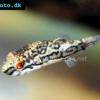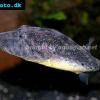Malabar pufferfish - Carinotetraodon travancoricus
Scientific name: Carinotetraodon travancoricus
Common name: Malabar pufferfish
Family: Tetraodontidae
Usual size in fish tanks: 2 - 3 cm (0.79 - 1.18 inch)
014
Recommended pH range: 6 - 7
Recommended water hardness: 4 - 12°N (71.43 - 214.29ppm)
0°C 32°F30°C 86°F
Recommended temperature range: 24 - 28 °C (75.2 - 82.4°F)
The way how these fish reproduce: Spawning
Where the species comes from: South Asia
Temperament to its own species: aggressive/territorial
Temperament toward other fish species: peaceful
Usual place in the tank: Middle levels
Food and Feeding
Malabar Pufferfish, also known as Dwarf Pufferfish, are carnivorous and have a strong preference for live or frozen foods. They require a diet high in protein to thrive. The primary staple food should include bloodworms, brine shrimp, mosquito larvae, and daphnia. Snails are an essential part of their diet in captivity as they help wear down the pufferfish's constantly growing teeth. Without access to hard-shelled foods, their teeth can overgrow, leading to feeding difficulties. Feeding should occur twice daily, and it’s crucial to ensure that uneaten food is promptly removed to maintain water quality, as these small fish are messy eaters.
Although pufferfish are known for their love of live food, some individuals may learn to accept frozen or prepared foods over time, but it may require patience and consistent feeding attempts. Avoid flake food or dry pellets, as these do not meet their dietary needs and are generally ignored by the pufferfish.
Origin
The Malabar Pufferfish (Carinotetraodon travancoricus) is native to freshwater rivers, lakes, and streams in the Western Ghats of India, particularly in the state of Kerala. They are commonly found in slow-moving or still waters that are densely vegetated, providing ample cover and hunting grounds for their natural diet of small invertebrates. Their natural environment is warm and heavily planted, which should be replicated in the aquarium to provide the best care.
Sexing
Distinguishing between male and female Malabar Pufferfish can be tricky, especially when they are young. As they mature, males typically become more vibrant in coloration and develop a dark stripe along their belly. Males may also display small, faint blue spots behind their eyes. Females, on the other hand, tend to be rounder and less colorful. Behavior is also an indicator, as males often exhibit more territorial or aggressive tendencies, especially during breeding times.
Breeding
Breeding Malabar Pufferfish in captivity is possible but requires careful preparation. They are egg scatterers, and spawning typically occurs in heavily planted areas with fine-leaved plants or moss. A well-planted breeding tank with soft water conditions (pH 6.5-7.0) is recommended. To trigger spawning, slightly cooler water temperatures, ranging between 24-26°C (75-79°F), are ideal. The female will lay the eggs, and the male may guard them, although parental care is minimal once the eggs are laid.
The eggs hatch after approximately 4-5 days, and the fry are very small and fragile. Infusoria or other microscopic food should be provided for the fry during the early stages, gradually transitioning to larger foods like newly hatched brine shrimp as they grow. Keeping the fry separate from adults or larger fish is necessary to avoid predation.
Lifespan
With proper care, the Malabar Pufferfish can live between 4 to 5 years in captivity. Maintaining good water quality, a suitable diet, and a stress-free environment are crucial to helping them reach their full lifespan. Regular water changes, a stable temperature, and careful monitoring of water parameters will ensure a healthy and long life for your pufferfish.
Short Description
The Malabar Pufferfish, or Dwarf Pufferfish, is a small, highly active species that grows up to 2.5 cm (1 inch) in length, making them one of the smallest pufferfish species available in the aquarium hobby. Despite their small size, they can be quite aggressive and territorial, especially toward other pufferfish or slow-moving species. Because of their tendency to nip fins, they are best kept in species-only tanks or with fast-moving fish that can avoid their attention.
A well-planted aquarium with plenty of hiding spots and open swimming areas is ideal for this species. Tanks should include dense plant cover, such as Java moss, hornwort, or other fine-leaved plants, to provide both security and enrichment for the pufferfish. These fish thrive in soft, slightly acidic water with temperatures between 24-28°C (75-82°F). The tank size should be at least 80 liters (~20 gallons) for a small group, as overcrowding can lead to increased aggression.
Regular maintenance, including frequent water changes and proper filtration, is necessary as these fish are sensitive to poor water quality. Additionally, avoid keeping them with large, aggressive species or fin-nippers, as they can easily become stressed in such environments.
Pictures
Special thanks to Richard Smith for providing some of the pictures. Additional images were purchased by aqua-fish.net from jjphoto.dk.











 Red
Red  Striped
Striped  Amazon
Amazon  Red-spot
Red-spot  Bailey’s
Bailey’s  Thai
Thai  Figure
Figure  Fang’s
Fang’s  Green
Green  Coral
Coral  Giant
Giant  Congo
Congo  Green
Green  Humpback
Humpback  Mekong
Mekong  Bronze
Bronze